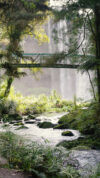All Downloads from the category: “Fauna & Flora”
Ludwigs et al. (2016) Appropriate Exposure Estimates for Wildlife Risk Assessments of Crop Protection Products Based on Continuous Radio Telemetry: A Case Study with Woodpegions
The registration of pesticides follows guidance published by the European Food Safety Authority (EFSA). As a default, the EFSA guidance document on risk assessment for birds and mammals assumes that animals feed exclusively on pesticide-treated fields.
Lückmann, Becker (2015) Honeybee brood studies under field conditions: Is there a difference of the brood termination rate compared to semi-field studies?
Based on EU Regulation 1107/2009/EC the current regulatory risk assessment on bees has to address the risk to honeybee larvae or honeybee brood. According to the data requirements under EC 1107/2009 Commission Regulation 284/2013 and the proposed EFSA Bee Guidance Document (EFSA 2014), both the Oomen bee brood feeding test (OOMEN et al. 1992) as well as the OECD Guidance Document 75 (OECD 2007) (hereafter called OECD GD 75) are given as the two higher tier options to refine the risk on honeybee brood if concerns are raised in tier 1.
Ludwigs et al. (2015) A statistical approach for selecting the most appropriate PT value for long-term wildlife risk assessments
In higher tier Risk Assessments (RAs) for Birds and Mammals, exposure takes into account the ‘portion of food taken from the treated area’, addressed by the surrogate parameter portion of time spent by birds or mammals potentially foraging in treated fields (the so-called PT value).
Haaf et al. (2014) Make a BeeCision – Is Insecticidal Activity of a PPP a Criterion to Trigger Laboratory Studies with Non-Apis Bees?
In 2013, under the new EU Regulation 1107/2009, the European Food Safety Agency (EFSA) published a new Guidance Document on risk assessment for pollinators (EFSA, 2013). In addition to assessments on honeybees, risk assessments on bumble bees and solitary bees are required.
Ludwigs et al. (2013) Sektion II: Methoden für landwirtschaftliche Gebiete - Bewertung von Vogelarten bei der Zulassung von Pestiziden in Europa
Es wird eine Übersicht zur Vorgehensweise der Risikobewertung von Vögeln zu potentiell durch Pfl anzenschutzmittel auftretenden akuten und reproduktiven Eff ekten gegeben. Grundlage einer solchen Risikobewertung ist die aktuelle Richtlinie (EFSA 2009) der europäischen Behörde für Lebensmittelsicherheit, EFSA.
Schmitzer, Lückmann (2013) Evaluation and Improvements of the Oomen et al. Bee Brood Test
Recent developments in the risk assessment of plant protection products (PPP) on bees (EU Regulation 1107/2009, EFSA 2013) promote the evaluation of potential effects on honeybee brood (Apis mellifera L.).
Dietzen et al. (2013) Focal Species of Birds in European Crops for Higher Tier Pesticide Risk Assessment
Focal species have been defined by the European Food Safety Authority (EFSA) as real species that represent others in a crop resulting from their potential higher level of exposure to pesticides. As such they are the most appropriate species for refining estimates of exposure further, through, for example, radio tracking and dietary studies.
Lutzmann et al. (2012) Appendix: List of reptile species and their potential occurrence in agricultural habitats
Murfitt et al. (2012) Bird focal species for pesticide risk assessment in orchards in Spain
This poster summarises the findings of Syngenta studies to identify focal species in four orchard crops in Spain. The aim is to show focal species for pesticide risk assessments in these crops and also to demonstrate the main principles involved in focal species selection.
Gerlach, Schabacker, Ludwigs (2012) Granivorous birds - Exposure reduction by de-husking behaviour
Granivorous birds of the families Passeridae (sparrows), Fringillidae (finches) and Emberizidae (buntings) are known to de-husk seeds prior to consumption. De-husking is an inhered behavioral trait of these species groups. A specialised beak structure allows the birds to crack seeds and discard the husk (i.e. de-husking) before swallowing the kernel – this was described in detail already by Ziswiler (1965).
Schabacker et al. (2012) Focal Bird Species for Amenity Grassland Risk Assessments
EFSA guidance (EFSA Journal 2009; 7/12) gives a list of crop groups and indicator species for the risk assessment of birds and mammals. For agricultural grasslands such as pastures and meadows, the default focal species given by EFSA are the house sparrow, linnet, pink-footed goose, and yellow wagtail.
Körner et al. (2012) Relevant Lizard Species for the Risk Assessment of Plant Protection Products in Northern and Central Europe
According to the new data requirements under the EU regulation 1107/2009, reptiles come into question regarding risk assessments of plant protection products (PPP). Although no specific data requirements on reptiles are stipulated in the respective EU documents (e.g. SANCO 11802/2010/rev July 2010) some toxicity data are available in the open literature. These data are intended to be used in the risk assessment.


